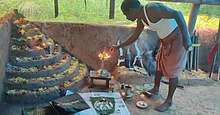Kalaripayattu
Kalaripayattu also known simply as Kalari, is an Indian martial art and fighting style that originated in modern-day Kerala.[1] Kalaripayattu is held in high regard by martial artists due to its long-standing history within Indian martial arts. It is believed to be the oldest surviving martial art in India. It is also considered to be among the oldest martial arts still in existence, with its origin in the martial arts timeline dating back to at least the 3rd century BCE.[2]
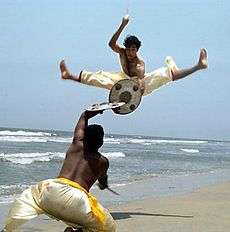 | |
| Also known as | Kalari |
|---|---|
| Focus | Hybrid |
| Hardness | Full-contact, semi-contact |
| Country of origin | India |
| Creator | Believed to be Parashurama. |
| Famous practitioners | Parashurama and Unniyarcha. |
| Parenthood | Indian martial arts |
| Olympic sport | No |
| Meaning | "Practice in the arts of the battlefield." |
| Part of a series on |
| Indian martial arts |
|---|
| Styles |
|
| Legendary Figures |
| Notable Practitioners |
| Related terms |
Kalaripayattu is also mentioned in the Vadakkan Pattukal ballads written about the Chekavar from the Malabar region of Kerala. The author Arnaud Van Der Veere confers the origin of martial arts to India (the roots of which are thought to be in Kalaripayattu), to which he refers to Kalaripayattu as "The Mother of All Martial Arts".[3] Kalaripayattu is a martial art designed for the ancient battlefield (the word "Kalari" meaning "battlefield"), with weapons and combative techniques that are unique to India.
Like most other Indian martial arts, Kalaripayattu draws heavily from Hinduism, and is based on Hindu medicinal concepts found in Ayurveda. Practitioners of Kalaripayattu possess intricate knowledge of pressure points on the human body and healing techniques that incorporate the knowledge of Ayurveda and Yoga. Students are taught the martial art as a way of life, with a sense of compassion, discipline, and respect toward the master, fellow-students, parents and the community. Particular emphasis is placed on avoiding confrontational situations and using the martial art only as a means of protection, when no other alternative is available.
Unlike other parts of India, warriors in Kerala belonged to all castes.[4] Women in Keralite society also underwent training in Kalaripayattu, and still do so to this day. Keralite women such as Unniyarcha are mentioned in a collection of ballads from Kerala called Vadakkan Pattukal, and are praised for their martial prowess.
In contemporary times, Sri Meenakshi Amma, a 73 year old gurukkal from Vadakara, was awarded the Padma Sri by the Government of India for her contributions to the preservation of Kalaripayattu.[5][6]
Styles
There are two major styles that are generally acknowledged within traditional Kalaripayattu. They are the Northern style, or Vadakkan Kalari, and the Southern style, or Thekkan Kalari.[7]
A newer style of Kalaripayattu called the Central style, or Madhya Kalari, which claims to combine elements of the Northern and Southern styles of Kalaripayattu is also being taught in Kerala. The legitimacy of this style is controversial due to its recent development and the lack of consensus of its existence amongst Kalaripayattu practitioners.[8]
A smaller, regional style of Kalaripayattu called Tulunadan Kalari, is referenced in texts such as the Vadakkan Pattukal, but it is largely restricted to the Tulu Nadu region in northern Kerala and southern Karnataka.
Other smaller, regional styles are also said to exist in isolated regions of Kerala, but these styles are becoming increasingly rare, and difficult to find.
History
The word, “Kalaripayattu,” is said to be derived from the from the name of Hindu deity Khaloorika Bhagavathy.[9] The word Kalari is also found in Sangam literature. The Akananuru and Purananuru describe the use of spears, swords, shields, bows and silambam in the Sangam era. The word kalari also appears in the Puram (verses 225, 237, 245, 356) and Akam (verses 34, 231, 293) to describe both a battlefield and combat arena. The word kalari tatt denoted a martial feat, while kalari kozhai meant a coward in war. Each warrior in the Sangam era received regular military training[10] in target practice, horse and elephant riding. In that period and during later periods, the word used for military and military service was chevam. The warriors or soldiers in military service were called Chekavar. They specialized in one or more of the important weapons of the period including the spear (vel), sword (val), shield (kedaham), and bow and arrow (vil ambu). The combat techniques of the Sangam period were the earliest precursors to Kalaripayattu.[11] References to "Silappadikkaram" in Sangam literature date back to the 2nd century. This referred to the silambam staff which was in great demand with foreign visitors.[12][13]Other sources state that the word Kalari is derived from first three letters of Sri Vidhya Mantra.[14]
Elements from the yoga tradition as well as finger movements in the nata dances, were incorporated into the fighting arts.[15] A number of South Asian fighting styles remain closely connected to yoga, dance and performing arts. Some of the choreographed sparring in Kalaripayattu can be applied to dance[16] and Kathakali dancers who knew Kalaripayattu were believed to be markedly better than other performers. Until recently, the Chhau dance was performed only by martial artists. Some traditional Indian classical dance schools still incorporate martial arts as part of their exercise regimen.[8]
Kalaripayattu includes strikes, kicks, grappling, preset forms, weaponry and healing methods.[16] Regional variants are classified according to geographical location in Kerala; these are the Northern style from the Malabar region in northern Kerala, and the Southern style from southern Kerala. Northern Kalaripayattu, or "Vadakkan Kalari" is based on elegant and flexible movements, evasions, jumps and weapons training, while the southern "Thekkan Kalari" style specializes in hard, impact based techniques with priority on hand-to-hand combat and pressure point strikes. Both systems make use of internal and external concepts. Warriors trained in Kalaripayattu would use very light, and basic body armor, as it was difficult to maintain flexibility and mobility while in heavy armor. Some of the methods used to enhance flexibility in Kalaripayattu are also utilized in Keralite dance forms such as Kathakali.[16] Dancers in Kerala who had experience with Kalaripayattu were noted to be markedly better than the other performers. Some traditional Indian dance schools still incorporate Kalaripayattu as part of their training regimen.
Techniques and teaching

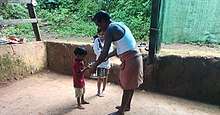
Traditions and methods of teaching of Kalaripayattu varied between different regions of Kerala. Kalaripayattu is taught in a specialized training ground known as a Kalari. Each kalari is built in accordance to Hindu architectural treatises such as the Vastu Shastras and Shilpa Shastras, along with various religious traditions and customs native to Kerala. The presiding deity of Kalaripayattu is said to be Shiva as well as Bhadrakali. Before every training session in the Kalari, salutations are provides to the presiding deities in the form of a mantra, or prayer.
Kalari Salutation Mantra :
"സർവ്വ തന്ത്രസവരൂപായ
സർവ്വ തന്ത്രസവരൂപിണി
സർവ്വഗായസമസ്ഥായ
ശിവായ ഗുരുവവ നമഃ”
(Sarva Thantra Swaroopaya
Sarva Thantra Swaroopini
Sarvagaya Samasthaya
Shivaya Guruve Namath)
Historically, all Keralites of the Hindu community, men and women alike, would undergo mandatory training in Kalaripayattu beginning at the age of 7 or 9 and lasting until the end of their education.[17] Warriors, soldiers and others who wanted to pursue a martial career would continue their training for the rest of their lives. Generally, two styles of Kalaripayattu are acknowledged among Kalari practitioners: the Northern Style and the Southern Style.[7] These two systems are quite similar, but their training methods begin to diverge to specialize in either weapons or hand-to-hand combat. The styles are variations that various masters have adapted and modified according to their understanding of the art. Development and mastery of Kalaripayattu comes from the tradition of constantly learning, adapting and improving the techniques by observing what techniques are practical and effective. There is a great amount of respect and observation of tradition which allows the preservation of the art. The knowledge and experience gained by the practitioners is improved upon by subsequent masters who utilize keen observation, research of various techniques and variations to update the knowledge. The adaptability of Kalaripayattu is largely due to Kalaripayattu being designed for use in warfare and combat. A Kalari practitioner might encounter new fighting techniques from an enemy combatant. The Kalari practitioner would need to learn how to anticipate, adapt to and neutralize these new techniques. This is especially seen in the Southern style of Kalaripayattu, which is believed to have been adapted and modified during wars with Tamil kingdoms to counter martial arts like Silambam, which was one of the main martial art forms practiced by Tamil soldiers at the time.[18] Kalaripayattu is ultimately taught not just as a martial art, but as a way of life that epitomizes respect, compassion and duty over all else.[19]
Northern style
The Northern style is also known as, Vadakkan Kalari, and is generally regarded as the "original," form of Kalaripayattu. This system places more emphasis on physical flexibility exercises and strength training rooted on the slogan Meyy kanavanam, meaning, "make the body an eye." These exercises are done individually, as well as in combinations. After that meypayattu (a concept similar to kata in Karate) is taught. These are a combination of flexibility exercises with offensive and defensive techniques, however, the actual techniques are taught very much later. Traditionally, the number of meypayattu may differ as per the teaching methods of the Guru. After the student learns meypayattu, stick fighting is taught. Generally, the majority of the Kalaris (schools that teach Kalaripayattu) start training with weapons within 3 to 6 months. Some Kalaris only allow one weapon to be learned per year. After long stick and small stick fighting, iron weapons are introduced. Training begins with the dagger, sword and then the spear. Not all modern schools use specialized weapons. Traditionally, bows and arrows were commonly used in Kerala and students were trained in these techniques, but is rarely taught today.[20]
Kalaripayattu has three forms, which are distinguished by their attacking and defensive patterns. They are Arappa Kayy, Pilla Thangi, and Vatten Thiripp.[21]
Southern style
The Southern style is also known as Thekkan Kalari. The origin of Thekkan Kalari is a subject of much debate and controversy. It is a style of Kalaripayattu that is said to have been altered and influenced by Sage Agastya. It may have been altered from the Northern style of Kalaripayattu to fight combatants trained in Adi Murai and Silambam from Tamil Nadu during various wars and skirmishes with Tamil kingdoms. It is essentially a style which combines Kalaripayattu with certain elements of Adi Murai and Silambam. Other sources suggest that martial arts such as Varma Kalai and Adi Thadi may also have influenced the Southern style. While the Southern style is less commonly practiced in Kerala compared to the Northern style, it is revered in Kerala as a combination of the teachings of both Parashurama and Agastya. It is predominantly practiced in some regions of the southern parts of Kerala, particularly in areas near Kanyakumari. While many of the exercises of the Southern style are identical to the Northern Style, it places heavy emphasis on hand-to-hand combat and hard impact techniques, and places less emphasis on weapons and combinations. It starts with the training in Chuvadus: a system of various combinations of fighting techniques similar to Muay Thai and shadow boxing. Immediately after that, sparring with a partner is introduced as part of the training. These pre-determined techniques are repeatedly trained. After a basic proficiency in unarmed combat is established, weapons training begins with a small stick. Small stick training is usually done with two combatants, armed with a stick or dagger. These are primarily defensive techniques. Fighting techniques with two combatants having the same weapons include sparring with long stick, sword, etc. During the duration of this training, the refining of un-armed combat also progresses. As the student gains more experience, a small amount of knowledge pertaining to the Marma points (pressure points) is also taught to the student if deemed appropriate by the Gurukkal.[22]
Kalaripayattu techniques are a combination of steps (Chuvadu) and postures (Vadivu). Chuvadu literally means 'steps', the basic steps of the martial arts. Vadivu literally means 'postures' or stances which are the foundations of Kalaripayattu training. They are named after animals, and are usually presented in eight forms. Styles differ considerably from one tradition to another. Not only do the names of poses differ, but their utilization and interpretation vary depending on the Gurukkal's preference, and the traditions of the Kalari. Each stance has its own style, combination, and function. These techniques vary from one style to another.[16]

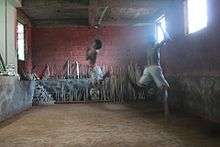
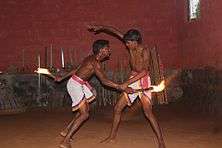
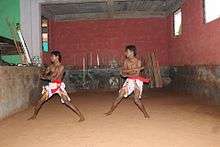


Marmashastram and massage

It is claimed that experienced Kalari warriors could disable or kill their opponents by merely striking the correct marmam (vital point) on their opponent's body. This technique is taught only to the most promising and level-headed students so as to discourage misuse of the technique. Marmashastram stresses on the knowledge of marmam and is also used for marma treatment (marmachikitsa). This system of marma treatment originated from Ayurveda, as well as Siddha medicine. Critics of Kalaripayattu have pointed out that the application of marmam techniques against neutral outsiders has not always produced verifiable results.
The earliest mention of marmam is found in the Rig Veda, where Indra is said to have defeated Vritra by attacking his marmam with a vajra.[23] References to marmam are also found in the Atharva Veda.[24] With numerous other scattered references to vital points in Vedic and epic sources, it is certain that India's early martial artists knew about and practiced attacking or defending vital points.[11] Sushruta (c. 6th century BC) identified and defined 107 vital points of the human body in his Sushruta Samhita.[25] Of these 107 points, 64 were classified as being lethal if properly struck with a fist or stick.[15] Sushruta's work formed the basis of the medical discipline Ayurveda, which was taught alongside various Indian martial arts that had an emphasis on vital points, such as Varma kalai and Marma adi.[15]
As a result of learning about the human body, Indian martial artists became knowledgeable in the fields of traditional medicine and massage. Kalaripayattu teachers often provide massages (uzhichil) with medicinal oils to their students in order to increase their physical flexibility or to treat muscle injuries encountered during practice. Such massages are generally termed thirumal and the unique massage given to increase flexibility is known as katcha thirumal. It is said to be as sophisticated as the uzhichil treatment of Ayurveda. Kalaripayattu has borrowed extensively from Ayurveda and equally lends to it.
Documentaries
- Among the earliest known documentaries on Kalaripayattu is a BBC documentary titled The Way of the Warrior.
- Kalaripayattu was also documented in Season 2 of Fight Quest.
Popular culture
The resurgence of public interest in Kalaripayattu began in the 1920s in Thalassery, as part of a wave of rediscovery of the traditional arts throughout southern India[16] and continued through the 1970s surge of general worldwide interest in martial arts.[26] It has featured in international and Indian films such as:
- Thacholi Othenan (film) (1964),
- Aromalunni (1972)
- Ondanondu Kaladalli (Kannada) (1978)
- Oru Vadakkan Veeragatha (1989)
- Asoka (2001)
- The Myth (2005)
- The Last Legion (2007)
- Kerala Varma Pazhassi Raja (film) (2009)
- Manasara (2010)
- Urumi (film) (2011)
- Commando (2013)
- Bajirao Mastani (2015)
- Baaghi (2016)
- Veeram (2016)
- Padmaavat (2018)
- Kayamkulam Kochunni (2018)
- Junglee (2019)
See also
- Angampora
- Banshay
- Bataireacht
- Bōjutsu
- Gatka
- Adimurai
- Indian martial arts
- Kendo
- Krabi–krabong
- Kuttu Varisai
- Mardani khel
- Silambam
- Tahtib
- Thang-ta
- Varma kalai
- Ankam
- Kalarippayattu films
- Kalarippayattu stick fighting
- Malayali
References
- https://ia802801.us.archive.org/27/items/ahandbookonkalaipayattuorg/A%20Handbook%20on%20Kalaipayattu%20Org.pdf
- Deleury, Guy (2005). India: The Rebel Continent. Macmillan. p. 89. ISBN 1403924880.
- van der Veere, Arnaud (2012). Muay Thai. Meyer & Meyer Verlag. p. 8. ISBN 9781841263281.
- Zarrilli, Phillip B. (1992). "To Heal and/or To Harm: The Vital Spots (Marmmam/Varmam) in Two South Indian Martial Traditions Part I: Focus on Kerala's Kalarippayattu". Journal of Asian Martial Arts. 1 (1).
- https://www.bbc.com/news/av/magazine-37038134/the-sword-fighting-granny-showing-the-young-how-it-s-done
- https://www.thehindu.com/society/history-and-culture/meenakshi-amma-the-grand-old-dame-of-kalaripayattu/article25307782.ece
- "About Kalaripayattu". Kalaripayattu Class. Retrieved 10 December 2019.
- Luijendijk, D.H. (2008) Kalarippayat: The Essence and Structure of an Indian Martial Art, Oprat, ISBN 978-1-4092-2626-0
- "A Handbook on Kalaripayattu".
- Subramanian, N. (1966). Sangam polity. Bombay: Asian Publishing House. (Wayback Machine PDF)
- Zarrilli, Phillip B. A South Indian Martial art and the Yoga and Ayurvedic Paradigms. University of Exeter.
- Raj, J. David Manuel (1977). The Origin and the Historical Development of Silambam Fencing: An Ancient Self-Defence Sport of India. Oregon: College of Health, Physical Education and Recreation, Univ. of Oregon. pp. 44, 50, & 83.
- Sports Authority of India (1987). Indigenous Games and Martial Arts of India. New Delhi: Sports Authority of India. pp. 91 & 94.
- https://ia601500.us.archive.org/20/items/ahandbookonkalaipayattuorg/A%20Handbook%20on%20Kalaipayattu%20Org.pdf
- J. R. Svinth (2002). A Chronological History of the Martial Arts and Combative Sports. Electronic Journals of Martial Arts and Sciences.
- Zarrilli, Phillip B. (1998). When the Body Becomes All Eyes: Paradigms, Discourses and Practices of Power in Kalarippayattu, a South Indian Martial Art. Oxford: Oxford University Press. ISBN 978-0-19563-940-7.
- "....#CVN KALARI#..." cvnkalari.in. Retrieved 10 December 2019.
- Association (WSA), World Silambam (5 June 2019). "Indian Traditional Arts". World Silambam Association (WSA). Retrieved 10 December 2019.
- "Kalaripayattu: Original Martial Art from Kerala, India". Blog. 21 March 2018. Retrieved 10 December 2019.
- "Kalaripayattu | Art & Culture of Kerala | Kerala | Kerala". Retrieved 10 December 2019.
- Karunan, Valappil. "Kalarippayattile Kanakkukal Kalariprayogaprakaram". Retrieved 4 January 2020.
- "Agasthya Kalari - for Siddha Treatments, Kalari Marma Treatments and offers training in Kalari strictly based on ancient scripts - located in Cochin, Kerala, India". agasthyakalari.org. Retrieved 10 December 2019.
- Mariana Fedorova (1990). Die Marmantheorie in der klassischen indischen Medizin.
- Subhash Ranade (1993). Natural Healing Through Ayurveda (p. 161). Passage Press. Utah USA.
- G. D. Singhal, L. V. Guru (1973). Anatomical and Obstetrical Considerations in Ancient Indian Surgery Based on Sarira-Sthana of Susruta Samhita.
- Zarrilli 1992
Further reading
- Balakrsnan, Pi (1995) Kalarippayattu: The ancient martial art of Kerala, C.V. Govindankutty Nair Gurukka 1995, ASIN B0006F9ONS
- Denaud, Patrick (1996) Kalaripayat, Budostore, ISBN 2-908580-62-4
- Elgood, Robert (2005) Hindu Arms and Ritual: Arms and Armour from India 1400-1865, Eburon Publishers, ISBN 90-5972-020-2
- Zarrilli, Phillip B. (1992) "To Heal and/or To Harm: The Vital Spots in Two South Indian Martial Traditions"
- Zarrilli, Phillip B. (1993) "Actualizing Power and Crafting a Self in Kalarippayattu", Journal of Asian Martial Arts
- Adhithya Kiran (2020) "A Hand book of Kalaripayattu",
External links
| Wikimedia Commons has media related to Kalarippayattu. |
Kalaripayattu: The First Martial Art
- Kalarippayattu - one of the oldest martial arts, Government of Kerala website
(Wayback Machine copy)
